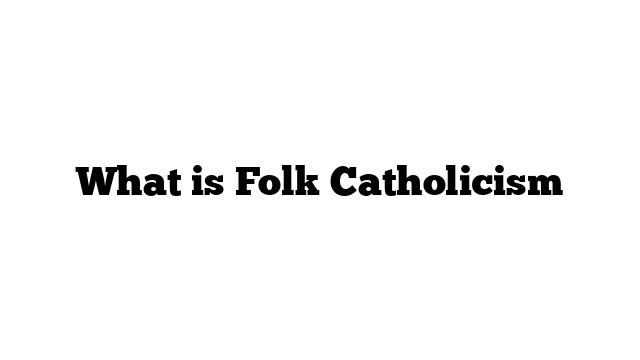Miscellaneous
What is Folk Catholicism?
Folk Catholicism is a term that refers to the amalgamation of Catholicism with local folk beliefs and practices. It often occurs in regions with large Catholic populations, such as Mexico, Ireland, and parts of Latin America. In these areas, Catholicism has integrated various superstitions, customs, and traditions that are deeply rooted in the local culture.
Origins of Folk Catholicism
The origins of Folk Catholicism can be traced back to the early days of Catholicism’s spread to new regions. When Catholic missionaries arrived in these areas, they encountered a pre-existing religious and cultural landscape. Rather than completely eradicating the local beliefs, the Church often incorporated elements from these traditions into its own teachings. This process is known as syncretism.
Syncretism and Adaptation
Through syncretism, Catholicism adapted to local cultures and traditions, allowing it to gain a foothold in new territories. It allowed the Church to be more accessible and relatable to the local population, making the conversion process easier. As a result, Catholicism fused with various indigenous beliefs, creating a unique blend of practices and customs.
Beliefs and Practices
Folk Catholicism encompasses a wide range of beliefs and practices, which may vary based on the specific region and cultural context. Some common elements include the veneration of saints, devotional practices, and folk rituals. For example, in Mexico, the Day of the Dead combines Catholic traditions with indigenous rituals, where families honor and remember their deceased loved ones.
Saint veneration is an integral part of Folk Catholicism. Saints serve as intercessors between humans and God, and individuals often turn to them for assistance and protection in various aspects of life. Each saint is associated with specific areas of expertise or patronage, such as St. Anthony for lost objects or St. Jude for desperate situations.
Devotional practices are also prevalent in Folk Catholicism. Pilgrimages to holy sites, such as shrines or basilicas, are common manifestations of devotion. Individuals seek spiritual healing, guidance, or miracles through these journeys. Additionally, religious processions, novenas (nine days of prayer), and rosaries are significant forms of devotion in Folk Catholicism.
Folk rituals are another aspect of Folk Catholicism. These rituals may involve the use of sacramentals, such as holy water or blessed objects, to ward off evil or bring blessings. It is important to note that while these practices may not be officially endorsed by the Church, they hold deep cultural and emotional significance for the local communities.
Controversies and Criticisms
Folk Catholicism has faced criticism from certain segments within the Catholic Church. Some argue that it blurs the line between authentic Catholicism and superstitious beliefs. Critics claim that these practices deviate from the teachings of the Church and may lead to a lack of understanding and reverence for core Catholic doctrines.
However, supporters of Folk Catholicism argue that it allows for a more inclusive and adaptable expression of faith. They maintain that incorporating local customs and traditions does not dilute the essence of Catholicism but rather enhances its relevance and resonance within different cultural contexts.
Conclusion
Folk Catholicism is a dynamic and complex phenomenon that reflects the intersection of Catholicism with local folk beliefs and practices. It is an expression of cultural adaptability and the fusion of different religious traditions. While debates and controversies surround its place within the Catholic Church, Folk Catholicism continues to play a significant role in the spiritual lives of millions around the world, bridging the gap between faith and culture.

